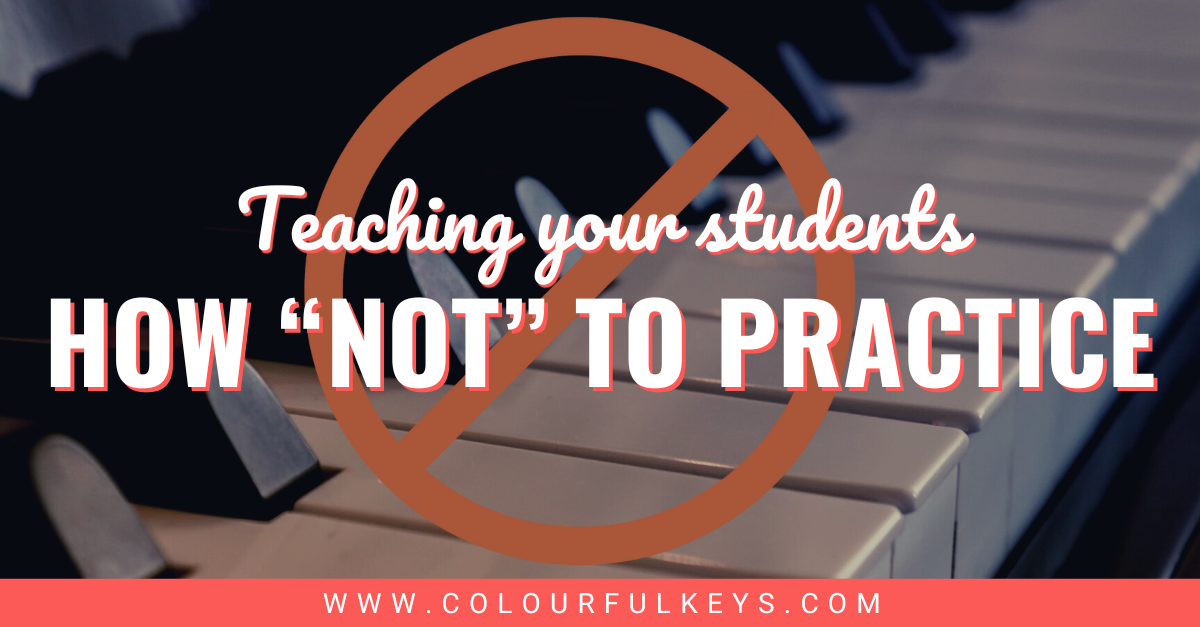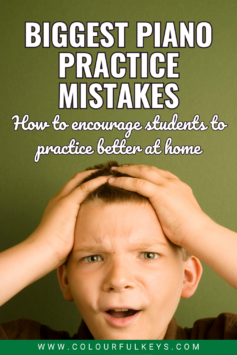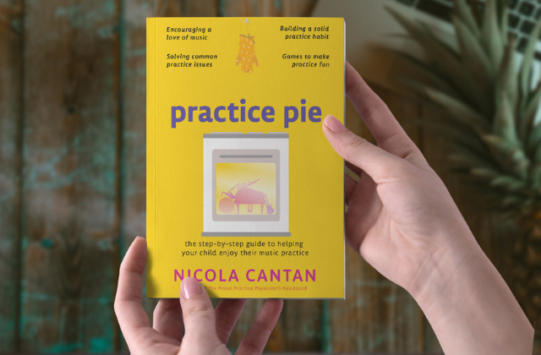
This blog post about music practice mistakes to avoid was written by Carmen Carpenter. Carmen has taught music in a school setting as well as in her home studio for more than 30 years. Teaching combines two of her favourite things: music and kids! Besides teaching music, Carmen loves spending time with family playing games, working puzzles and watching movies. She’s also an avid reader and loves taking long walks on her local, woodsy trails.
It’s easy to assume that if students are involved in sport or dance or some other activity that involves “practising”, they know what piano practice should look and sound like. But in most of these activities, practice is a meeting they simply show up for and follow the directions and guidance of a coach or director. Is practising these activities really comparable to practising piano?

Piano practice is a whole different ball game. The piano teacher isn’t at a student’s house directing their practise by telling them where to start, what they need to work on or how to fix mistakes.
In my 30+ years of teaching piano, I’ve seen my fair share of students who are entirely misguided in their approach to practising. (Honestly, it doesn’t take 30 years of teaching to notice when a student is practising the wrong way.)
Here are the top mistakes I’ve seen, and some strategies I use to help my students overcome them.
Setup Slip-ups
If students aren’t properly prepared for practice, it’s unlikely they’ll have an effective practice time.
Practice Mistake No. 1: Avoidable Distractions
Students tend to be acutely aware that having their cell phone’s notifications turned on is a recipe for disaster when it comes to concentrating on study of any kind. But have you explored other distractions your students may be dealing with at home? Things like:
- Family members moving in/out of the room your student is practising in
- Background noise like a loud TV in another room or cooking sounds coming from the kitchen
- The piano facing a window where the student can easily see their friends merrily playing outside (FOMO, anyone?)
Remind students, and parents, that their instrument should be in a space that allows for full concentration on the task at hand – practising piano.
That means you may have to send an email or make a phone call to some piano parents and inform them they need to take the keyboard out of the bedroom or put the piano in a room that doesn’t house the family printer.
Tough conversations, yes. But the results are worth it in the end.
Practice Mistake No. 2: Lack of Preparation
Many students think that all they should do to get ready to practise is to put their bum on the piano bench.
But once they get to playing, they realise they’ve forgotten their binder or sheet music or method book. Once they find that, they start playing and notice a tricky spot they’d like to mark for deliberate practice later so they have to get up and go find a pencil or highlighter. After finding that writing utensil, they circle or swipe, start playing, then decide they need to go to the bathroom. You get the picture.
How about arming your students with a pre-practice checklist? You could include things like:
- Get a drink of water or grab your water bottle
- Use the bathroom
- Have a pencil and/or highlighter on the piano or in easy reach
- Tell family members you’re practising so they can keep the noise down
- Find your assignment sheet and music books
A great way to make sure your students have what they need for an effective practice session is to provide them with a practice kit which includes pencils, highlighter, sticky notes, etc.
Want help creating your very own practice kits? Enter your info below and we’ll send everything you need straight to your inbox.

Subscribe to updates and get the Practice Kit
Enter your details to subscribe to the newsletter for piano teachers with information, tips and offers.
I hate spam as much as you do! I’ll only send you information that’s directly relevant to music teachers and you can unsubscribe at any time.
If you’re a member of Vibrant Music Teaching, you can download the kit instantly from the VMT Library. Not a member? Never heard of the membership? Still on the fence? Learn more and join today at vibrantmusicteaching.com.
I like to use a 3-ring pencil pouch which can stay in their binder so those things are right to hand during practice.
Playing Pitfalls
How the student actually works on their piano pieces and exercises is, of course, the most common area for missteps and boo-boos when practising.
Practice Mistake No. 3: Tackling Too Much
For most students, if you assign a new piece by simply writing ‘Minuet’ on a practice sheet, they’ll most likely try to perfect the whole piece in one week. As great as it may sound to have a student master a piece (or two) a week, this isn’t actually the best strategy for long-term, sustainable learning.
I have a student who can easily learn a piece in a week. But if I ask that student to play that same piece 3 weeks later, she’s already forgotten it. That’s because she learnt the whole thing at once instead of breaking it down into smaller parts that she grappled with, repeated and polished.
If your student is working on a larger or more difficult piece, make a habit of assigning one section at a time so your students can more easily and effectively implement the “best practices” for practising, including an interleaved or spaced repetitions approach with a variety of practice strategies.
Practice Mistake No. 4: Too Fast, Too Soon
This is the habit that I just can’t seem to break for my speedy students.
True story: I once had a student preparing for a recital who sounded quite good if he played his piece just a bit more slowly. So when I asked if he’d rather play slow with almost no mistakes or fast with lots of mistakes, he said fast.🤦🏻♀️ Seriously?
In lessons, it can be good to “force” students to play slower by playing the melody along with them at a slower tempo. Then tell them that’s how slow you’d like them to practise. I like to refer to it as “sloth speed”.
In many cases, it can actually be difficult to slow ourselves down. That’s when a metronome or drum backing track can help. Be sure to include the bpm you want them to use on their assignment sheet, in their practice app or at the top of the music page, and confirm with the parents that they have access to a metronome or suitable app.
Practice Mistake No. 5: Mindless Repetitions
Repetition is a necessary part of good practising. I myself use repetitions in my own practice on the regular. But simply playing something over and over again – especially if it’s an entire song – is not the best use of repetitions.
Help your students get the most out of repetitions by introducing them to interleaved and spaced repetitions.
The VMT Library has some fantastic resources to guide students in using these practice techniques. My favourites are ‘Lasagne & Layers’, ‘Mastery Pathery’ and ‘Practice Plays’.
If you use the Vivid Practice app, you can assign a specific “practice mode” for each piece, including interleaved and Pomodoro approaches. This makes it easier for students to get out of the “mindless repetition” trap.
Nicola has devoted an entire section of her website to teaching students how to practise. Hop on over for the latest and greatest tips and tricks.
Faulty Frame of Mind
The attitude a student has about practicing is quite possibly the most important factor to ensure a productive practice session.
Practice Mistake No. 6: Low Tolerance for Sounding “Messy”
Every so often, I have to remind my students that an effective practice session just won’t sound that good or be particularly exciting or fun to listen to.
Effective practice sounds like small bits played over and over again, starting in the middle of the piece instead of the beginning and only playing the entire piece at once after many sessions of mistake-ridden practice.
Some practice is even silent – from analysing a section to writing down scale fingering, parts of a practice session might not have any sound at all!
The thing is, even if you’re able to convince the student that quality practice often sounds like a hot mess, it can be hard to make their parents and family believe it.
Be sure you teach your piano families the difference between playing and practising. Let them know that practice won’t be pretty and that “playing the piano” can only be achieved through lots of messy-sounding practice sessions.
Have you seen Nicola’s book ‘Practice Pie’? It’s a fantastic resource for piano parents to learn about how to support their child’s home practice. Consider giving or lending a copy to all your new piano families, and follow up by talking about it with them.
Practice Mistake No. 7: Not Giving Up
I imagine you were expecting me to say something about how important it is to face challenges to ensure sustainable learning, and, yes, I’m a huge believer in that.
But what I’m talking about here is the tendency to not give up when you actually should.
- Sometimes, you really are too tired and just plain “played out”. Embrace that and stop practising.
- When the notes are blurring together on the page and your fingers are starting to twist together like pretzels, it’s time to call it a day.
- You’ve played the same two bars 23 times and you’re still missing that one note, it’s OK to move on. Work on something else instead, and come back to those two bars later.
Remind your students – and yourself – that it’s entirely acceptable to have some boundaries for your practice times to keep your mental state intact.

What’s the biggest practice mistake your students are guilty of?
Tell us all about it in the comments below.

